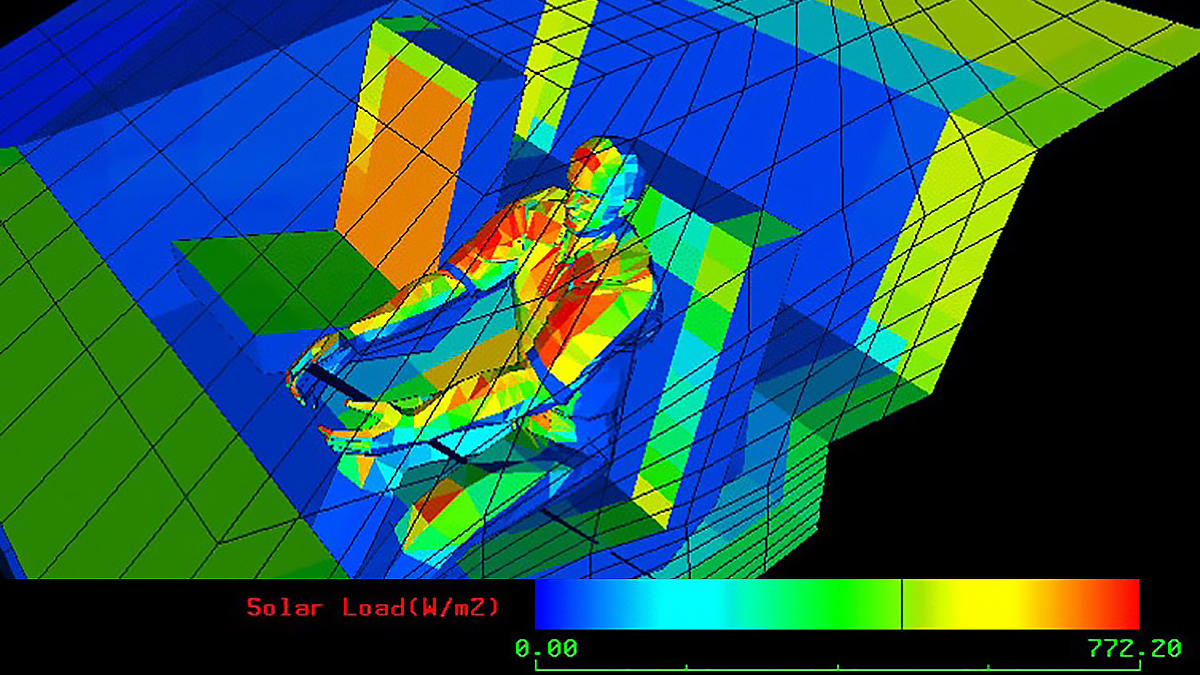Using CBE’s world-class thermal comfort resources to improve comfort in automobiles.
Status: Current
Funding Sources: National Renewable Energy Laboratory (NREL) U.S. Department of Energy Automotive Industry
Project Objective
To apply the concepts of the personal comfort systems and UC Berkeley’s advanced thermal comfort model to the design of the automobile in order to optimize heating and cooling efficiency as well as user comfort.
Significance to Industry
The research team at CBE has developed and tested personal comfort systems (PCS), which describe a set of devices that offer energy-efficient heating and cooling alternatives to traditional HVAC. This approach allows people to tailor their environments to suit their own temperature needs and preferences, and has been demonstrated in lab and field studies to provide better comfort than seen in conventional one-size-fits-all approaches.
This approach is particularly applicable in automobiles, which create dynamic and non-homogenous thermal environments, with passenger comfort being impacted by various factors ranging from solar effects, the location of vents, and the circulation of air within the vehicle. In automobile cabins, the PCS concept can be used to address the fundamental problems that arise with traditional thermal systems. Previously, thermal comfort studies treated the human body as a uniform, cylindrical entity. Extensive laboratory testing with human subjects, carried out by CBE Research Specialist Hui Zhang, found that overall discomfort is dictated by the combination of discomfort of individual body parts, and that these ‘local’ effects are not equally weighted. For example, in warm conditions the head is most important to ensuring one’s overall comfort, while in cooler conditions extremities are most important. By focusing solely on ambient temperature, conventional HVAC approaches neglect these critical details, using more energy with less effectiveness.
Research Approach
This body of work began with Hui Zhang’s 2003 dissertation, which empirically studied skin temperatures on various parts of the body, as well as overall comfort and thermal sensation in non-uniform and transient (changing) environments. This work was supported through the National Renewable Energy Laboratory (NREL) by U.S. DOE’s Office of FreedomCAR and Vehicle Technologies (OFCVT) and led to the creation of the Advanced Thermal Comfort Model. This model was validated through a series of wind tunnel tests conducted by Delphi Technologies, a major manufacturer of automotive systems.
In later phases of this work, Zhang and CBE Director Prof. Edward Arens developed and tested innovative heating and cooling strategies to provide more energy-efficient thermal comfort in vehicles, based in part on the research team’s depth of understanding of human thermal physiology and thermal comfort. The researchers developed a car mockup in CBE’s controlled environment chamber and conducted human subject tests to compare the effectiveness of various local heating and cooling strategies. This mockup included an “anteroom” to simulate various outdoor temperatures and to study how the strategies work once people enter a car. These strategies included a ventilated car seat, and air vents incorporated into headrests, seat belts and pillars (the supports around car windows). This work was done in collaboration with General Motors and Delphi, with funding from the U.S. Department of Energy.
In addition to these milestone projects, CBE has also collaborated on vehicle comfort research with Hyundai, Faurecia, Ford, and the U.S. Army. The research team also conducted a series of tests on the use of a computer driving game as a method of increasing the realism for test subjects, and examining the physiological effects of using the game. The metabolic rates of subjects playing or watching the game were found to be very close to their rates when driving or riding in a real car.
Publications and Reports
Wang, M., E. Wolfe, D. Ghosh, J. Bozeman, K. Chen, T. Han, H. Zhang, and E. Arens. 2014. Localized cooling for human comfort. SAE International Journal of Passenger Cars-Mechanical Systems, 7(2), 755-768. https://escholarship.org/uc/item/9x2366mk
Zhang H, E. Arens, C. Huizenga, T. Han T. 2010. Thermal sensation and comfort models for non-uniform and transient environments: Part III: whole-body sensation and comfort. Building and Environment, 45(2), 399-410. https://escholarship.org/uc/item/2tm289vb
Zhang, H., Arens, E., & Arens, C. 2002. Using a driving game to increase the realism of laboratory studies of automobile passenger thermal comfort. SAE Technical Paper Series 2003-01-2710. https://escholarship.org/uc/item/4bq4n92h
Huizenga, C., H. Zhang, et al. 2001. A model of human physiology and comfort for assessing complex thermal environments. Building and Environment 36(6), 691 – 699. Also in Proceedings, 6th Annual International Building Performance Simulation Association (IBPSA) Conference, Kyoto, Japan, September 1999. https://escholarship.org/uc/item/3sq8z441

